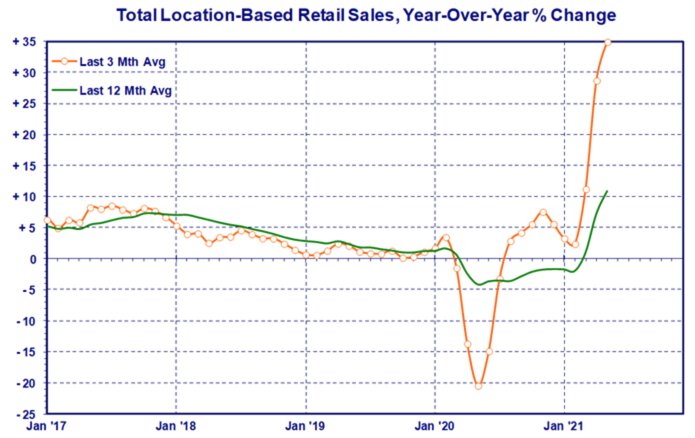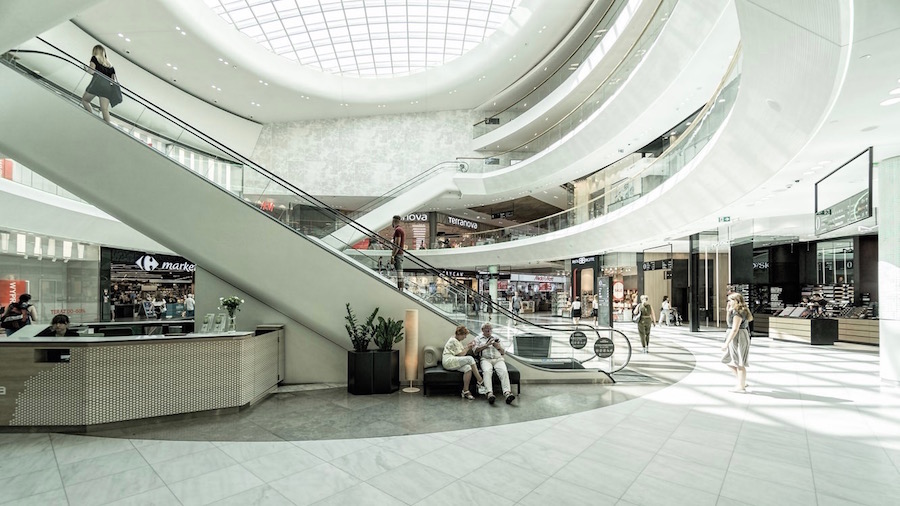The proliferation of online shopping has done little to stem the success of brick and mortar retail in Canada. Sure, last year’s economic lockdowns obliterated shopping mall foot traffic for a period, but location-based retail sales skyrocketed as soon as the doors to Canada’s centres opened back up. Clearly, sales from 2021 were greater than 2020, but have a look at the growth from 2019 and prior:
 Source: Retail Insider
Source: Retail Insider
Why the growth? For one, consumers are eager to return to normal life, and a day at the mall is about as normal as it gets. Then there’s the fact that 30% of the workforce (as high as 70% in some industries) works from home (WFH) and has the physical freedom to leave “the office” and spend disposable income wherever they please. But it goes beyond that, as Canadian retail centres have long invested in providing a superior shopping experience.
“Canada’s top shopping malls continue to thrive with leading centres investing in their properties and courting top domestic and international retailers. While many top malls in Canada are performing much better than their US counterparts, it is because landlords in Canada are continually refreshing their physical retail spaces to keep them experiential, creative and consumer centered.” (RetailCouncil.org)
Canada’s malls check all of the boxes in regards to physical layout, accessibility, and diversity of retail. However, it’s a cutthroat business when it comes to vying for customers. Those who intend to become more competitive than the complex in the next district are turning to digital marketing – even if they aren’t partaking in eCommerce from their respective websites. If you’re among them, the time to capitalize on the growth in consumer interest is now. Below are the key steps to making that happen.
Top Five Digital Marketing Tips for Major Shopping Centers
I. Update Your Website
Your physical retail complex may be experiential, creative, and consumer focused, but does your website also provide a superior experience? If you haven’t updated it for function and aesthetics over the last two years, probably not. Google has recently laid out new requirements regarding on-page experience, which include an audit of the following:
- Page loading performance
- Interactivity
- Visual stability
- Mobile responsiveness
- Safe browsing (including HTTPS)
- Inclusion or absence of interstitials (i.e. pop-ups)
In addition, in the same manner that your physical spaces must be made accessible to people of all abilities, your website must also abide by accessibility guidelines. Recently, Canada’s Federal Court of Appeal asserted that inaccessible websites may violate the Constitutional Rights of visually impaired Canadians. A shopping mall, which is a gathering place for an entire city’s diverse communities has an inherent responsibility to ensure that it is welcoming to everyone – and that includes their digital presence. Update your website to account for the World Wide Web Consortium (W3C) Web Content Accessibility Guidelines (WCAG).
II. Satiate the Timid Consumer
Despite the recent growth in location-based sales, a number of consumers remain timid about returning to crowded retail arenas. If your mall offers curbside pickup for products purchased from your retailers online, ensure that this feature is prominently displayed on your website’s homepage, and is communicated weekly on your social media profiles. And of course, make it clear on the same digital channels that you meet or exceed provincial mandates regarding health and safety protocols.
III. Use Digital Roads to Turn “Location” Into “Destination”
There’s a big difference between being a location-based centre, and a “destination”. A location-centric retailer is one that is planted in a high-traffic area so it can take advantage of its visibility and convenience. You’ve already got that covered, but you can only depend upon local foot traffic for so long. A destination centre on the other hand, compels consumers through unique differentiation and/or branding to arrive there by making a conscious decision to do so.
To compete with your city’s other multi-retail establishments you must communicate your differentiation and value proposition to turn your mall into a destination. Unlike location-focused centres, you can only communicate this through marketing. Billboard advertising on the turnpikes and highways leading to your mall were once the primary channel, but now you must focus on digital freeways.
For starters, make sure that your Google My Business profile is 100% completed and updated with new photos and posts each week. In addition, attract high-value consumers from nearby communities and cities through geo-targeted PPC campaigns and paid ads on social media. Facebook and Instagram allow retailers to target very explicit demographics at a relatively low cost. The recent Facebook Neighborhoods platform is something you’ll want to capitalize on as well.
IV. Support Your Retailers
The number and diversity of the retailers within your mall is a big part of your differentiation strategy. It’s important to leverage your website and social network following to promote them. Their success is your success, and vice versa.
Every shop, eatery, and service provider within your mall should have a dedicated (and search engine optimized) page on your website. This increases their visibility, and keeps your website’s visitors from leaving your site to search for more information on each retailer. The latter typically occurs when mall’s website simply lists them (without added information) on their store directory. You can also update retailer-pages when each has a new sale or offer that they want to communicate to destination-shoppers. With these dedicated pages in place, you will have more ammunition to feature valuable retailers on your social networks.
V. Event Marketing
A shopping mall is more than a place to shop and eat. It’s where consumers go to hangout and immerse themselves in a variety activities. Malls host everything from morning walks for seniors and charity drives to cultural performances and live music concerts. During seasonal holidays they become a beacon for households. This all gives you the opportunity to use your website as so much more than a directory of retailers.
Develop a more robust event section on your website. I should include an interactive calendar that maintains annual events, and is frequently updated with one-off events too. Each event should also have it’s own dedicated webpage so that you keep visitors on-site when they want to learn more. In addition, create social media campaigns (paid and organic) for each festivity, allowing for at-least one month of lead time to promote it. Lastly, publish a blog post and/or press release about each event within two-weeks of it’s arrival date.
Shopping season is around the corner (no matter when you read this) so the time to update your digital marketing strategy is now. Receive a free consultation by contacting Strategis Consulting Group at your earliest convenience.

